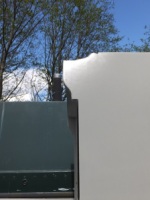Yesterday we made the trip up to Sheffield to catch up with the build. NB Oleanna was sitting out in the yard with a 2 part epoxy blacking and then a primer coat to protect her from the elements. The shell is finished with all the little twiddly bits. Inside has been painted too to stop any rust and the next stage is for her to be painted, wooden battens added to the interior and then spray foamed.
It is maybe easiest to talk through the photos.
Looking from the bow. the rubbing strakes follow round the curve of the bow. The base plate has been cut away to shape around the shape of the hull. Rings are visible where the bow fender will be attached.
There are no front doors as these will be made of hard wood and glazed.
The few scratches on the paint work of the bow are from the hull being moved around the yard on fork lifts and will be touched up.
Side view of the bow. You can see how the bow curves upwards. There is a silver coloured sacrificial anode towards the bottom of the hull. There are four of these in all. 2 either side of the bow and two either side of the stern. Next to the anode is the grill at the end of the bow thruster tube. This is to stop objects from being pulled into the propeller inside the tube and fowling the thruster.
This shows the top of the bow and the lid of the gas locker. These are the only fake rivets on Oleanna. The T stud is where the bow line will attach for mooring.
Below here there is space for two 13kg bottles of LPG which we will use to cook with and we will possibly have a gas central heating boiler too.
The cratch board will sit to the furthest right of the photograph, supported by a cross member to the roof of the boat, this will then have a cratch cover attached, covering the well deck.
Curves and mouldings to the steel work add extra interest. The moulding on the right gives water the chance to run off the roof at these points.
The next few photos show the inside of the cabin, first looking back to the stern, then the bow. Holes in the ceiling are for the mushroom vents which help prevent us from suffocating when all the doors are closed. You can make out the inside of the stern doors, these are steel, but will be lined with wood.
Around the porthole closest to the bow extra uprights have been welded to the cabin side. These must be so that there are secure fixing points for the cupboards that will be in here.
 The pipes coming out from the side of the cabin are for drains from appliances.
The pipes coming out from the side of the cabin are for drains from appliances.
The furthest forward is for the washing machine which will be at Mick’s side of the bed, then the shower followed by the bathroom sink. These are all positioned above water level outside, otherwise they would let water in and we’d sink. The shower will require a gulper/pump to suck the water up and over the side.
Looking at the stern doors. Below them is what looks a bit like a letter box. However this will actually be a vent into the galley from the engine bay, this gives enough ventilation without having to have vents in your back doors. The rear cabin steps will sit here centrally.
The pipe coming through the rear bulk head is for cables, water pipes etc. There is a matching one on the other side too.
The low box/cheese wedge is the swim of the hull, this takes up quite a bit of space at the rear of the cabin and stops you from being able to use these areas for appliances.
Three of these are on the exterior gunnel sides and where you can attach fenders. However from past experience we would be very unlikely to attach them here. The temptation to cruise with your fenders down is too great and lifting them a bit of a phaff. This is also the most likely reason that we have over the last couple of years gained several fenders, around our prop, that have been lost by other boats in locks when their fenders were down. We are more likely to attach fenders to the grab rail by using wooden hooks. These you can position where you need them and then just lift them out of the way completely. So why still have these? They will be very useful when we moor as we could use them to tie additional lines creating what are known as springs. Having two lines going in opposite directions from the bow and stern mean that you are less likely to move in strong winds or when speeding boaters pass.
View down the starboard side, another boat in the way.
The port side showing the side hatch that will be opposite our dinette, window in the centre of photo will be the galley. The grill on the side of the boat is for ventilation into the engine.
Below the stern you can see the point where the swim has a hole for the prop shaft to come from inside, this will be where the propeller sits. Behind this is the rudder which pivots in a cup that is attached to the swim.


















Proper job! Now Where's the like button ummmm.